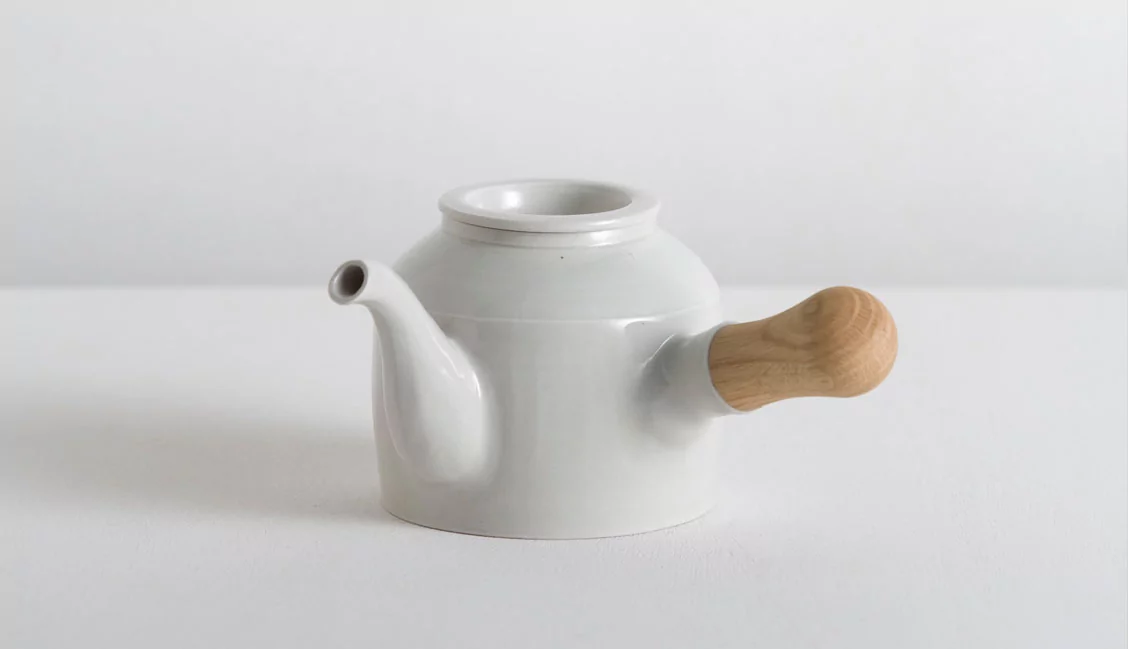
ABOUT MATTHIAS KAISER
Matthias Kaiser is an Austrian Potter who’s style focuses on simplicity and functionality. He studied at Parsons school of design in NY and at Vienna’s university of applied arts, he then apprenticed with two Japanese master potters in Seto and Karatasu.
You can find Matthias making pots at his studio in Vienna, Austria.
Interview date: 11th of January, 2013
INTRODUCTION
Continuing a sway towards craft led design in our interview format is Austrian potter and all round creative Matthias Kaiser. We were lucky enough to divert his attention away from the wheel for a moment to discuss what inspired him to turn craft into career, the path he’s taken so far, along with the techniques he uses to create his own distinct and endearing style.
What impressed me personally about Matthias and his creations was the fact he takes so much influence from his local surroundings: the mountain terrains of Styria and Vienna. Here he sources the majority of the materials found in his pots, bowls and cups, digging and refining his own clay from a local pit, as well as creating their respective glazes from scratch.
DID YOU KNOW?
1. WHO IS MATTHIAS KAISER AND WHAT DOES HE DO?
I still haven’t found out!
2. DO YOU HAVE A WORKING PHILOSOPHY?
Find the best possible materials to work with, gather as much information as possible, practice as much as possible. Those are the basics. Don’t think that you are working as long as you are still concerned with the basics.
3. WHAT WAS THE CAREER PATH YOU TOOK AND IS THIS ONE YOU WOULD RECOMMEND TO OTHERS EAGER TO TURN CERAMICS INTO THEIR PROFESSION?
Initially I went to New York to study music, but changed to product design after about one year. I continued that for 2 years before moving to Japan and apprenticing with two potters for one year each in Seto and Karatsu. After returning to Austria I enrolled at the University of applied arts in Vienna and eventually opened a studio in Styria province.
My aim was to expose myself to a variety of traditions and ways of learning and I feel that it has given me the proper tools for starting my own ceramic experience. The learning continues, of course, through more travels and exchanges with other artisans and artists. I would not want to recommend any one path to a student of ceramics, simply because I have always wanted to find my own way and refused to listen to advice.
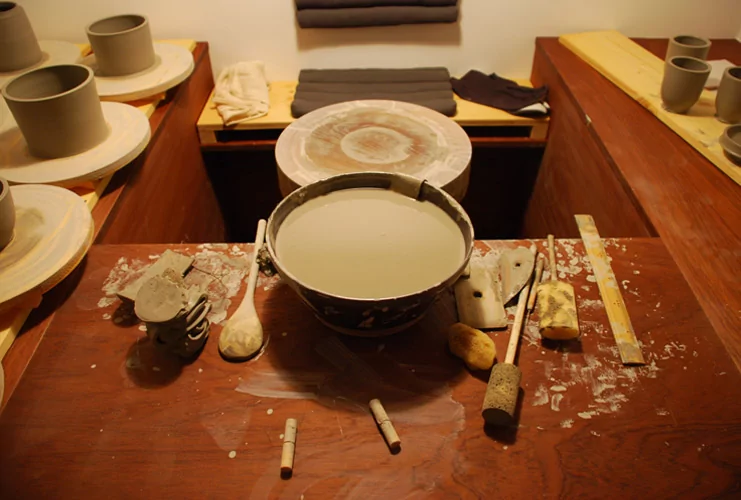
A look at potter Matthias Kaiser’s studio wheel and utensils in Vienna, Austria.
4. HAVE YOU ALWAYS BEEN A MAKER, AND WHERE DID YOU FIRST PICK UP A PIECE OF CLAY AND BEGIN THROWING ON THE WHEEL?
I used to be more of a dreamer/observer/collector and still crave the joys and frustrations connected with those activities. My first pot was cut from the wheel in the basement of Parsons school of design, I was hooked right from the start and usually the one to turn off the lights. Gradually I became addicted to the crucial moment of creation and now I am mostly interested in the process of perpetual improvement, finding it quite easy to let go of finalised work.
5. YOUR TIME ABROAD HAS OBVIOUSLY INFORMED YOUR DAY TO DAY WORK SIGNIFICANTLY, SO WHAT WOULD YOU SAY WERE THE MOST INFLUENTIAL PLACES YOU’VE VISITED AND WHY?
No doubt every place that I’ve spent more than a few weeks in has been inspiring and influential in some way. Each has its own attitude and style, with my story woven into it and connected to circumstances and people. To name a few:
Flensburg, Germany’s northernmost city and my mother’s hometown, for the insight that home can be abroad. New York, for losing my nationality and finding a vocation. Seto and Karatsu, for receiving a thorough training as an artisan. Tehran and Karaj, for giving me a chance to live life backwards. Chandigarh and Bombay, for showing me that excitement and boredom are two sides of the same coin.
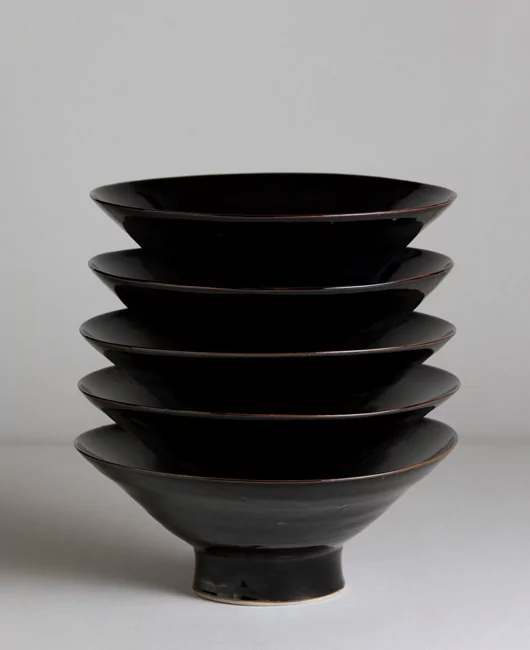
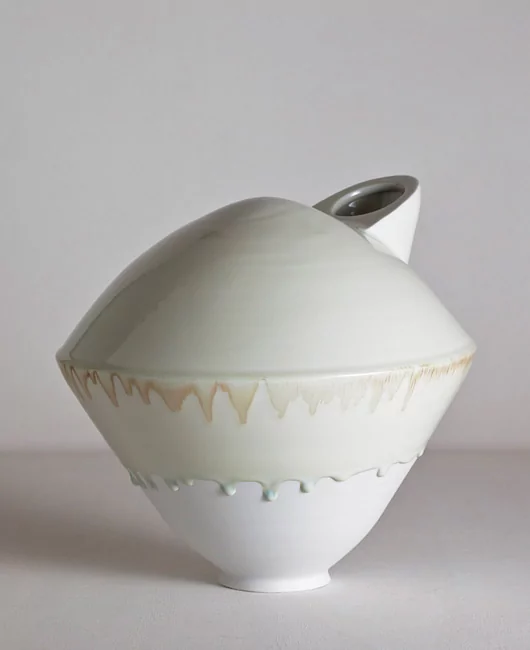
6. AS A SOCIETY WE ARE NOW OFTEN DETACHED FROM THE PROCESS AND HISTORY BEHIND A PRODUCT, WITH THE MOST VALUE NOW PUT ON HASTE AND LOW PRICE. IN CONTRAST TO THIS, WHY DO YOU BELIEVE IT’S IMPORTANT FOR PEOPLE TO SEE VALUE IN TRADITIONAL CRAFTS SUCH AS CERAMICS, WOOD WORKING, AND OTHER SUCH HANDMADE GOODS?
We are what we choose to make part of our lives. Most of us do have a choice, anyway. If we select things of a certain nature to surround us and start to learn about them, we will fine tune our perception and become more aware. That is true wealth.
7. WHO FOR YOU ARE YOUR BIGGEST INSPIRATIONS, BOTH IN TERMS OF WHAT YOU DO AND OTHER MEDIUMS OF CREATIVITY, SUCH AS MUSIC, PHOTOGRAPHY AND ART?
Chinese Song dynasty ceramics are pretty cool. But there are some awesome ceramic artists around now. From the older generation I admire Sajiro Tanaka (pure poetry), Shiro Tsujimura (powerful yet restrained) and Koie Ryoji (powerful and daring). Kouichi Uchida and Takuro Kuwata are two younger potters with an over-abundance of talent and skill. Inspiration often shoots at me from an unexpected angle, however, could be a word, shape, sound, mood or memory. I sketch a lot, but time doesn’t allow me to realise every idea, most will never rise to the third dimension.
In art, music and literature I like a certain level of skill paired with the genuine simplicity that is associated with humility.
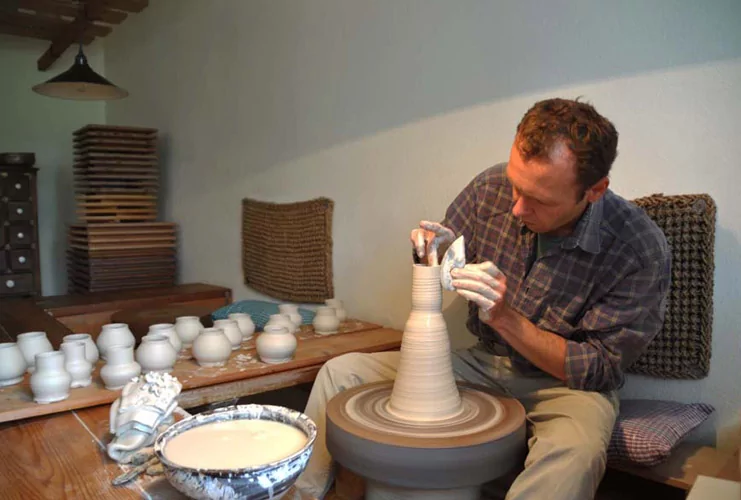
Matthias Kaiser making in his studio on a wooden kick wheel, influenced from his training in Japan.
8. WE REALLY ENJOY THE COMBINATION YOU CREATE OF VERY TRADITIONAL FORMS, SUCH AS THE KYUSU AND THE CHAWAN, WITH MORE PLAYFUL AND MODERN SHAPES, SOME EVEN VERY BAUHAUS-ESQUE. HAS THIS ALWAYS BEEN YOUR APPROACH AND WHAT INSPIRED YOU TO WORK IN THIS STYLE?
I like to keep my innovations gentle. That is due to the respect I have for the archetypal shapes that I work with. The more I learn about about them, the more I realize how much more there remains to learn. I try to make contemporary forms that are well-founded, the innovation should at least attempt to match the qualities of the traditional shape it is based on. It is also imperative to me that a piece of modern ceramic should have more qualities than just a single new idea. Soundness of making and an attention to nuances are key.
9. YOU WORK PREDOMINANTLY IN STONEWARE AND PORCELAIN, WHY IS THIS AND CAN YOU BRIEFLY DEFINE THE DIFFERENCE BETWEEN THE TWO FOR US?
Unbeknownst to most, they are essentially the same thing. Both are high-fired ceramics, meaning that a refractory clay, usually with a glass coating (glaze), is fired to a temperature in excess of 1200°C. Porcelain comes in shades of white, from pure white to light grey, because its main ingredient is kaolin. Kaolin is a primary clay, geologically younger, with a larger particle size and less contaminated by the most common colouring element in the earth’s crust, iron. Besides kaolin clay, a porcelain body usually consists of quartz and feldspar. Depending on the ratio, the type of kaolin and the firing temperature and atmosphere, the colour and translucency of the porcelain is determined. Some porcelains are translucent, some aren’t.
Because the particle size of porcelain clay is larger than that of stoneware clay, it is less plastic and therefore more difficult to throw on the potters wheel. Stoneware clay ranges in colour from white to dark brown, depending on the amount and type of elements that it contains. Usually quartz, feldspar and iron are present, besides a variety of other minerals. Stoneware clay is geologically older than kaolin, has a smaller particle size and can be very plastic and easy to throw on the wheel. However if it contains a large percentage of quartz, it can also be short and challenging to throw. Stoneware is not translucent despite being fired at a high temperature. Ceramics that are fired at temperatures of 1200°C or more are very hard and durable and can take everyday use.
If one wants to create something permanent, that is an obvious advantage. Low-fire ceramics such as terracotta, earthenware or Raku-ware have a charm of their own, but will chip, scratch and crumble easier and since they are not vitrified they are more difficult to use with food. Besides, the static concerns connected with high firing temperatures and their impact on the shape of a vessel are a worthy challenge for a professional potter. High-fire glazes and surfaces are another subject, I could go on…
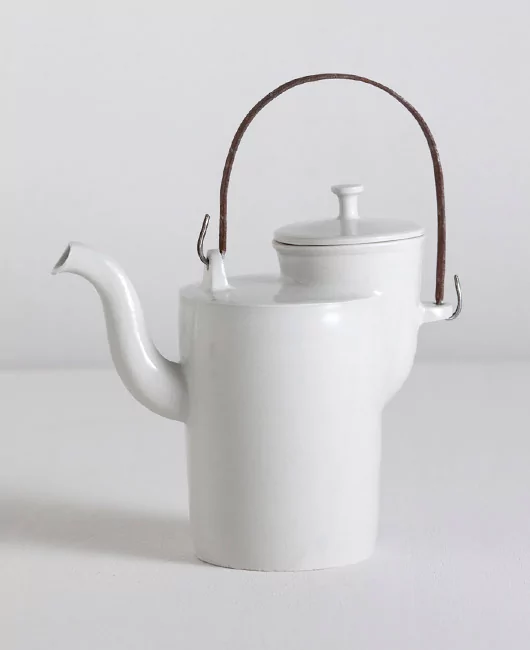
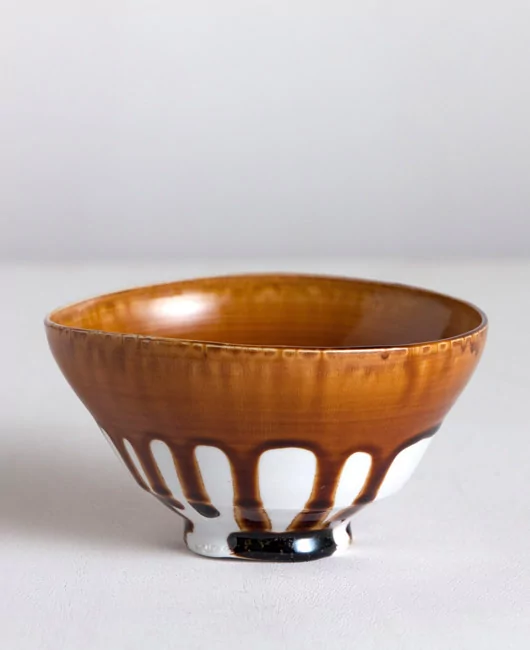
10. WE WERE AMAZED TO LEARN YOU DIG AND REFINE YOUR OWN CLAY, HOW LONG HAVE YOU BEEN EXPERIMENTING WITH THIS AND WHAT COMPELLED YOU TO WORK IN THIS WAY?
The materials you use influence your work, the process influences the outcome, so it seemed obvious to look into finding just the right materials. There is such variety and beauty in natural raw materials that the benefit of using them far outweighs the challenges they pose from a manufacturing point of view. I even like the limitations they pose. I have found that if there is more skill needed to master a certain task, the results are simpler and richer at the same time. My apprenticeships in Japan have very much broadened my thinking in this regard, when I first arrived there I was like a carpenter who had up to then only worked with plywood and slowly and at first reluctantly learned to appreciate the structure, grain and colour of solid wood.
11. AS FAR AS I’M AWARE YOU’VE ONLY EVER BUILT SCULPTURES IN ONE MATERIAL, HAVE YOU EVER BEEN INTERESTED IN EXPERIMENTING WITH ANOTHER OR PERHAPS COMBINING A FEW TO CREATE THE SAME DESIRED EFFECT.
When I am at home or working with friends any material is fair game. But in my public work, I still enjoy finding something new while holding the material constant. Each time I say, “What unique opportunities do I have in this situation that I will never have again?” Experimenting is a necessity but a career is built on focus and wringing huge potential from limited territory.
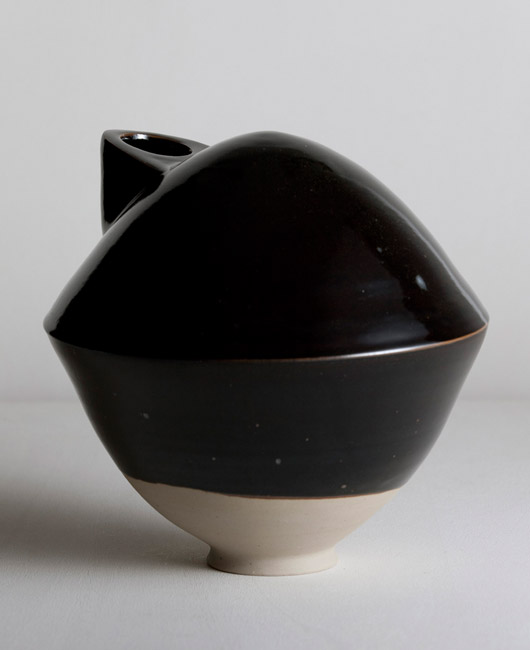
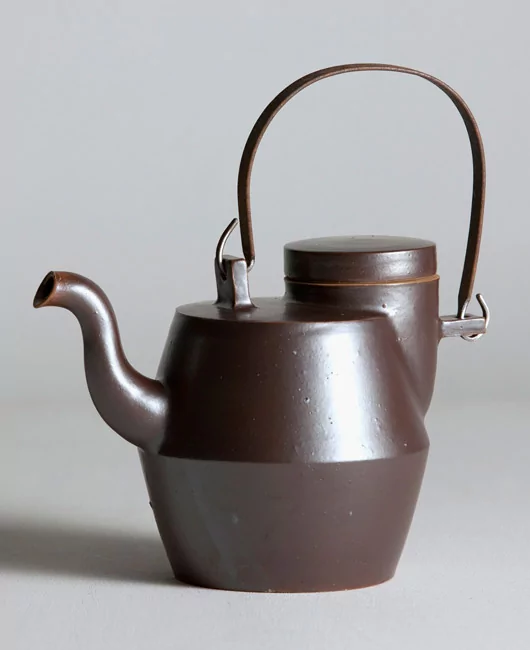
12. WOULD YOU SAY WORKING AS AN ARTIST LACKS FINANCIAL SECURITY? IF SO, WHAT WOULD YOUR ADVICE BE TO YOUNG ARTISTS CONSIDERING WORKING ON THEIR OWN PROJECTS FULL TIME?
Indeed. With close to 20 years of experience as a potter I still have losses in every single firing. Sometimes a lot of losses. Usually the glazes are the culprit. It’s also because I like to take risks, always try to push the envelope and attempt new things. Of course it would be possible to play it safer, but I don’t get very frustrated by wasters, it is always half-expected. It helps not to think about how much time and effort was in vain.
13. HOW KEY ARE EXHIBITIONS FOR A POTTER OR CERAMIST, OR HAS THE INTERNET PUT LESS EMPHASIS ON FACE TO FACE CONTACT?
In my experience personal relations are the most important factor in promotion and sales. They can be built over the internet, but I feel that exhibitions are an important tool for creating attention, bonding with existing customers and attracting new ones.
14. WE’VE SEEN YOUR PREVIOUS SCULPTURES AND IT MADE US WONDER, DO YOU PLAN TO CREATE ANY LARGER INSTALLATIONS IN THE FUTURE AND IF SO WHAT CAN WE EXPECT TO SEE?
At the moment I am experimenting with firing just sand, without clay. I mix sand with ash or feldspar and fire that repeatedly, also glazing it sometimes. A table I have made in this way will be up on my website soon.
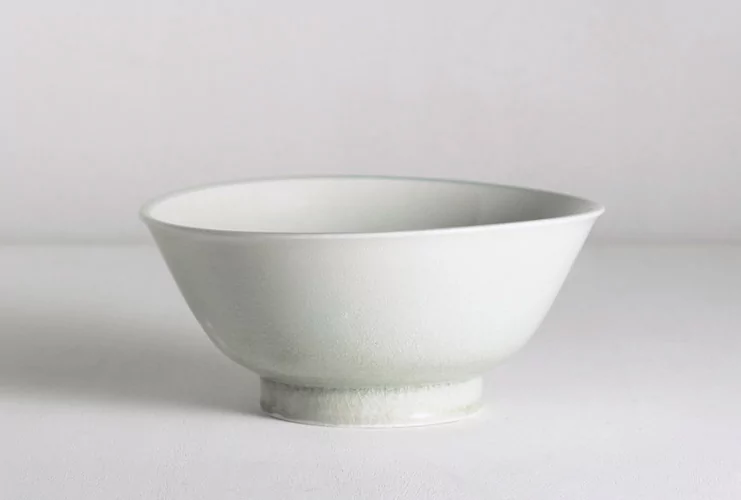
A simplistic white bowl with celadon glaze by Matthias Kaiser. The jade overlay colour is produced by iron oxide in the glaze recipe.




Post a comment